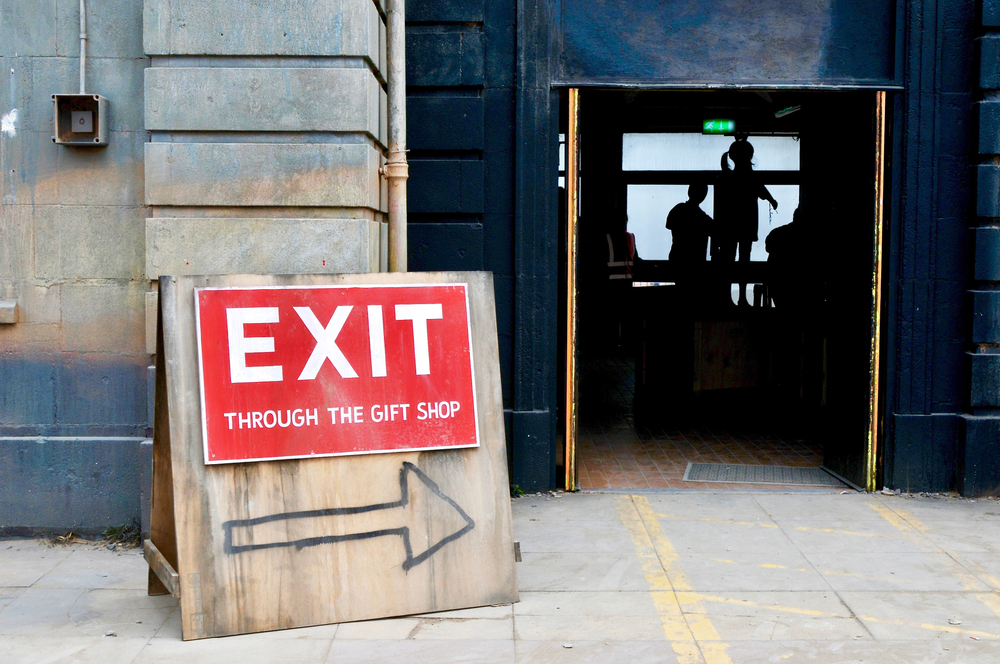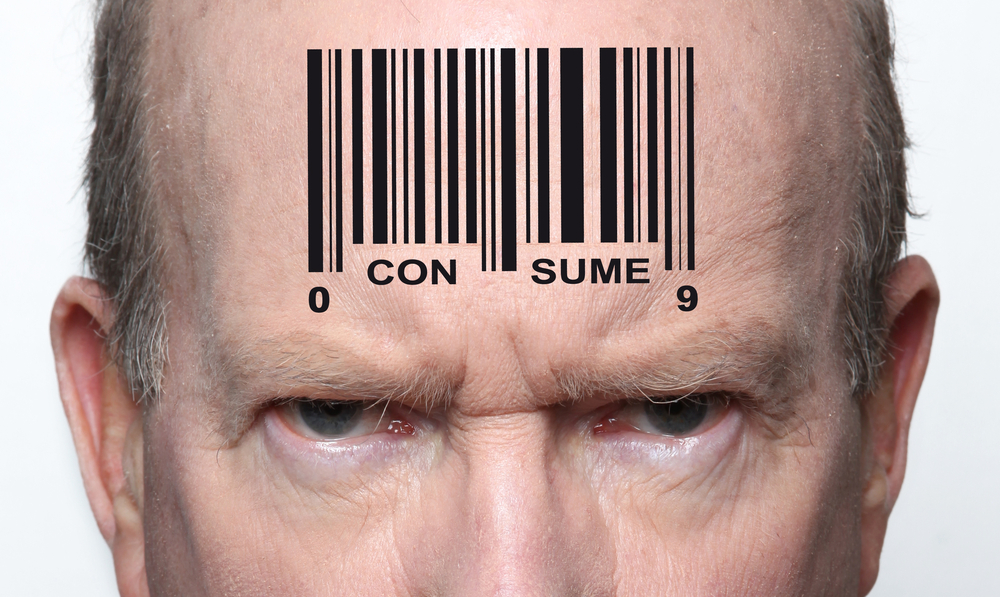What started out as a specialist bookshop with a few collection postcards and the odd poster, has become big business for galleries, and artists.
From pop-up vitrine stores in most regional galleries, providing a vital income stream, to global brands like The Met (Metropolitan Museum of Art in New York) and the Museum of Modern Art (MoMA) with chain outlet stores worldwide, art merchandise today is the norm.
Writer Toby Fehily dates ‘art souvenirs’ to the 1870s, when The Met, ‘was selling US$25 sets of Old Masters engravings. Thanks to one Bradford Kelleher, an aspiring cartoon animator who joined the Met as a sales manager in 1949, the museum’s art and book shop grew from what was once described as “little more than a rack of postcards” to a business that pulls in approximately $70 million per year (2007) – more than what the museum makes from admissions and memberships’.
A lot has changed since 2007. To exit through the gift shop – to adopt the title of street artist Banksy’s film from 2010 – has become standard modus operandi. And in March this year, Elliot Safra wrote for Artnet that the ever expanding market for art merchandise is ‘only just beginning’, in what may be considered a next wave boom with shop takeovers and brand collaborations driving ‘merch’ as a winning option.
Get it right and you tick an audience box and a dollar box. So is there space in this market for individual artists to develop, and sell, their own merchandise? And how can they also get a piece of this lucrative market?
Am I selling out?
COVID – and the e-commerce boom it bought for makers – has continued to break down the stigma of artists ‘selling out’ and selling online. With the increasing demand for creative merchandise, the door has opened for artists to seriously consider their own merchandise (or more familiarly ‘merch’) as an option.
Richard Harling – Manager of Retail and Publishing at the Art Gallery of NSW (AGNSW) for over 10 years and founder of The Cultural Commerce Consultant – described [retailing] in an earlier interview as ‘the holy grail is to enhance visitor experience’.
‘When people come to the gallery they either view the shop first or last – these are the strongest impressions,’ continued Harling. He noted that that plastic dinosaur or fridge magnet is not only a tangible reminder of a positive experience, but it advocates you as a creative supporter to others.
‘Build on that,’ he says. ‘When you think about your products don’t focus on things, rather think of a range. You want to tell a story; and that story will be shared.’
While artists have lots of stories, they don’t always have lots of time. Artist Matthew Dunn has turned to the platform Redbubble to develop his merch.
In an earlier ArtsHub article, he said: ‘When managed properly, a benefit can be that it does not require full-time attention. The more exposure your other projects gain, the larger the audience for your merchandise and vice versa.’
He said that while there will be people who have a negative opinion of artwork being made available ‘on a larger scale, just remember that those are just opinions and it’s up to you how much time and consideration you give them’.
Australian poet and artist Richard Tipping believes artists should be excited by the prospect of merchandise. ‘I love seeing my stuff on shelves in an art gallery shop – where it is likely to seen by many more people that any particular exhibition,’ he told ArtsHub contributor Madeleine Dore.
‘If you can design merchandise, which in itself counts as artwork, even better! Why not?’ He first started making arty merch in 1983, and today sells it to gallery shops in Australia, the US, the UK and Germany.

The future of merch
Artnet’s Elliot Safra wrote further of today’s growing trend: ‘Creating products is only the beginning. What museums are doing to [the] market, and [selling] their growing supply of merchandise, is even more eye-opening.’
Safra described how galleries like the Tate have organised takeovers of their retail spaces as brand collaborations with artists, to reimagine, ‘the store as an experiential space’, with bespoke merch, a hand-selected musical playlis, and a curated selection of books.
He also noted that mainstream brands are hungry to collaborate with artists, mentioning the Takashi Murakami-designed Hublot watch, David Salle swimwear for Orlebar Brown and companies like Ligne Blanche; to the flipside of that collaboration trend with artists increasingly opening their own shops.
Keith Haring may have been one of the first – and Ken Done in Australia – but today you can find David Shrigley’s Shrig Shop in Copenhagen, and artists like KAWS and Koons heavily marketing their merch. On a simpler level, many artists are also adding a shop / e-commerce facility to their websites.
‘My prediction is that this retail trend will continue to grow at an even faster pace and that the facets of the art world that have yet to adopt a retail practice will do so soon. Get ready to find gift shops at your favourite art fairs, catering to the enormous number of people who spend the day without purchasing anything more than a coffee, a sandwich, and maybe a ticket,’ concluded Safra.
Choosing the right merch for you
By its very definition, merchandising is the process of reproducing the art on another surface and marketing the new product.
What started out as postcards and posters, and then expanded to notebooks, calendars – and let’s go wild here – fridge magnets, t-shirts and tote bags, today is an incredibly diverse offering space, beyond our merchandising dreams.
Think umbrellas, hoodies, socks, phone covers, scarves, jigsaw puzzles (a big hit during COVID), coffee mugs, logo earrings, mousepads, skater decks, sneakers, water bottles, home décor … merch moves in trends and circles. It is high volume, fast paced and often trend driven.
For example, ‘The global market for socks was valued at about US$11.7 billion in 2018. So, novelty socks can be a great addition to your merch store,’ adding that the ‘cap industry in the US hit $2 billion in America alone in 2018,’ reports Lisa John.
But don’t just make socks because they are profitable, or a t-shirt because it is easy. In order to sell merch, you need unique ideas and products.
Similarly, there is currently a saturation of arty totes on the market – also used as giveaways – so think beyond the obvious first choice. The first question an artist must ask is, ‘what is the right merch step for me?’ Consider these questions:
- What kind of merch suits your art?
- Think of your supporters – is this something that would resonate with them?
- Is the quality in line with your studio production?
- What is financially manageable as an outlay to make sense?
- How are you going to stock and sell this merch?
- Does it have a wide enough appeal to be commercially successful?
- Do you have the time to manage and maintain supply to your stockists?
- Where would the merch sit in the marketplace – is it unique or too similar to other offerings?
If you’re still unsure sure what kind of merch fits your studio practice, why not ask your friends and supporters? Send out a survey to your email list or run a poll on social media to get some opinions. This way, you’ll be able to start developing your merch with confidence that people will actually buy it.
Read: 9 tips for selling your art online

Tips and advice from artists and stockists
When designing your merch, think about your brand – your fonts, colours and creative elements. More so, your merch should always point back to your brand – either your website or your name and logo. Get these in place before you consider merchandising. Have you ever seen a ‘merch t-shirt’ without a logo? Oh and no-brainer, but make sure your website and socials are equipped for selling merch. This sounds simple, but can take some time to set up.
Take the time to find the right company that produces high-quality items, and is transparent about their manufacturing process. Why not consider sharing the journey of your merch production, and ethical fabrication choice – it will boost sales.
Be aware of your rights if you choose granting a licence to a company that will produce and sell products displaying your art/designs. Ensure you set up a licence agreement that is a legal document so both parties are clear on terms: payment, copyright, limited use, volume, quality commitment.
Merc wizard Tyler Wallach, offers the advice: ‘Stay humble and don’t sign anything until your dad looks at it first.’
Decide if you want to print-on-demand or print in bulk. Print on demand will be more expensive, but will mean you won’t be stuck with odd sizes or unsold stock. It also means a slower delivery to customers.
When printing on demand, the artist uploads a digital image to the company’s website. The company offers an assortment of products, and produces them as customers place an order. The company then dispatches to the customer, and takes a fee for their services.
Printing in bulk, in contrast, will offer you cheaper unit rates, but you have to deal with storage and initial outlay. The upside is it is a quick send and enables you to offer speedy giveaways to build relationships and boost engagement during down periods.
Get your price point right and understand your competition. Work out the cost of production and the number of sales needed to break even on fabrication costs, before starting. ‘Eight of the 10 top selling shirts sold via Spotify [and its Merchbar outlet] were under $25. On top of that, fans buy t-shirts under $25 twice as often as t-shirts over $25!’ writes blogger Splice.
Richard Tipping adds: ‘The return needs to cover the costs of making and distributing, as well as keeping proper stock and tax records.’
Pay for professional photography to shoot your work at a standard for reproduction. This is where smart phone hacks don’t work. Offer views of the displayed object – and the used object – so customers can get a sense of scale and feel. And remember to ask your happy customers to social them wearing/using your merch. Nothings sells better than a personal recommendation.
One warning is to be aware of the ‘shelf life’ of some merch. If it is too closely attached to an event or exhibition, it will have a ‘has-been’ feeling as soon as the exhibition closes.
Don’t forget to factor in shipping – methods and costs. Shipping costs are one of the biggest factors in an online consumer’s purchasing decision, and aborting a sale at the cart. Be clear early in the process. Merchbar recommends to keep the shipping price as low as possible. ‘Anything above €5 (about AU$10) decreases your sales by an average of 20%.’
Also be aware of shipping delays and the added costs if working with international stockists or selling abroad, and don’t promise delivery if you can’t, over peak holiday periods.
People love free stuff, so think of bundle offers or a freebie with every purchase over a certain amount. This may be free shipping, or those totes you are stuck with.
Inventory and bookkeeping – these may be dirty words to artists – but necessary when you enter the world of merch and stockists. Be aware of your responsibilities and needs, before getting started.
In summary: the Pros and Cons
PROS:
- It offers an opportunity for a new revenue stream and more diversified price point.
- It provide exposure and visibility of your work.
- Merch turns your supporters into ambassadors of your work.
- It allows for a broader stockist footprint.
- They are a great source for giveaways.
CONS:
- It is competitive and it’s hard to find a unique niche to stand out.
- All that printing, packaging and shipping is not the most environmentally friendly option.
- Merch is driven by trends and if you misread the market you can get stuck with loads of stock, and feel the financial impact of that investment (gone wrong).
- It take time out of the studio to manage design, production, supply, stockists … and customers – the biggest time sinkhole, and a daily one.




